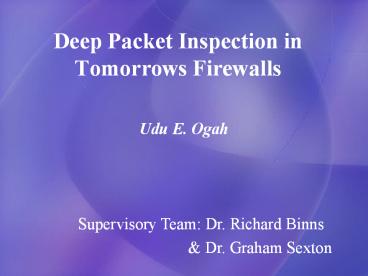Deep Packet Inspection in Tomorrows Firewalls - PowerPoint PPT Presentation
1 / 14
Title:
Deep Packet Inspection in Tomorrows Firewalls
Description:
Dr. Graham Sexton. Introduction. Security was not a major concern when communication protocols e.g. TCP/IP was developed. ... Can't fight against the ... – PowerPoint PPT presentation
Number of Views:508
Avg rating:3.0/5.0
Title: Deep Packet Inspection in Tomorrows Firewalls
1
Deep Packet Inspection in Tomorrows Firewalls
- Udu E. Ogah
Supervisory Team Dr. Richard Binns
Dr. Graham Sexton
2
Introduction
- Security was not a major concern when
communication protocols e.g. TCP/IP was
developed. - Lack of built-in security facilities
- Plaintext payload (commonly exploited by worms
e.g. msblast) - No source authentication
- Stateless forwarding
- Current security techniques
- edge-of-the-network
- Cant fight against the distributed attacks
- Firewalls
- Restrict the network activities of the internal
users - Failed to protect against the more sophisticated
DDoS
3
Introduction
- Rise in Web/Network attacks in recent years
- Rise in the number of people using the internet
- Marked rise in corporate businesses who have
opted for an online presence - Proliferation in the number of intelligent
viruses/worms and trojans attacking systems - Current security techniques
- edge-of-the-network
- Cant fight against the distributed attacks
4
Basic Definitions
- The OSI, or Open System Interconnection, model
defines a networking framework for implementing
protocols in seven layers. - For the purposes of this presentation, we will be
concerned mainly with - The Application Layer
- The Transport Layer
- The Network Layer
- These represent the layers at which Routers,
IPSs, IDSs, and ALGs(Application Level Gateways)
operate. - Intrusion Detection and Prevention Systems
5
The OSI Network Model
6
The OSI Network Model
7
Current Trends in Network Security
- Firewalls etc.
- - Stateful Inspection Firewalls
- - Perimeter/Edge-of-the-network Firewalls
- Intrusion Detection Systems
- Intrusion Prevention Systems
- Application Level Gateways
8
Problems of the existing Network Security Models
- The internet or TCP/IP internetworking was built
upon inherently flawed foundational protocols
e.g. ARP - Built primarily for connectivity and so didnt
bear security in mind - Any client machine is innately able to do
anything on a network subject to the availability
of appropriate tools and adequate user knowledge. - Network security implementations have always been
centralized, host-based. - Lack of built-in security facilities
- Plaintext payload (commonly exploited by worms
e.g. msblast) - No source authentication
- Stateless forwarding
9
- A Generic Network Security Model Example 1
Single layer model
- Disadvantages
- Failure of the firewall results in a security
breach for the whole network
10
- A Generic Network Security Model Example 2
A practical model
- Disadvantages
- Failure to protect
- against the more
- sophisticated DDoS
11
A Novel Approach
- This research will ultimately attempt at shifting
the focus of current network security models from
a host-based Intrusion detection/prevention
framework to a client-based implementation
12
How ?
- Exhaustive protocol verification to determine
what is normal/abnormal in application layer
protocols - Formulate rule-sets forming the basis of device
drivers which will be built into client adapters - This has the advantage of
- 1. Distributing the processing workload and
- taking the stress off Firewalls.
- 2. Making sure clients do only what they
are - permitted to do on a network hence
- changing the problem
13
Test Rig
- PC hardware based on the Linux/BSD Platform
(deploying the stable 2.4 series kernel) - Access to Low level kernel and network functions
via kernel mode device drivers - The core is written in C, affording extremely
fast packet capture and analysis using libpcap
(packet capture) libraries. - Freely available open source code will encourage
learning and development.(with due regard for the
Academic Alliance ?)
14
Invisible Bridging Firewall (Gentoo Linux based)
- Works at layer 2 (Datalink Layer) of the OSI
model - Has no IP address and hence is effectively
invisible on a network! - Has been kernel patched to filter IP-based
network traffic via the Netfilter/Iptables
framework. It can hence control and regulate
network packets and traffic even whilst still
invisible - It can be literally deployed in any point on a
network without any configuration changes. Hence
its an inline device. - These characteristics make it ideal as a
testbench for packet analysis, injection etc.
15
- Many thanks!































